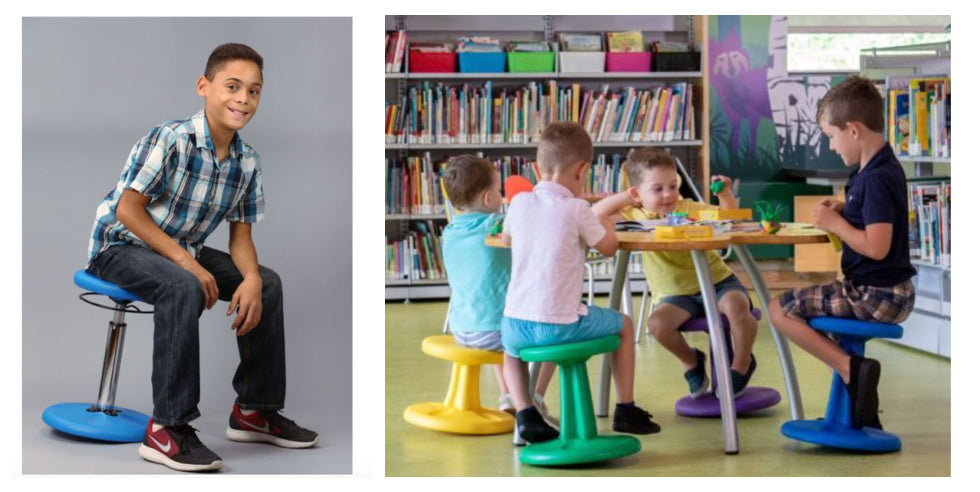The Benefits of Adding Flexible Seating to Your Classroom

Tapping toes, swinging feet, tipping chairs, falling out of desks . . . Do any of these things remind you of your classroom? Today’s students seem to need more input and more movement than ever before. Perhaps it is the increased use of screens both at school and at home, or perhaps it is just higher energy levels, but regardless of the reason, teachers are finding the need to adapt classroom teaching to the needs of these wiggly bodies within their four walls.
One method of providing students more opportunity for movement is through the use of flexible seating. Flexible seating is becoming increasingly popular both in the primary and secondary classrooms. It can look different in every classroom, but typically includes allowing students to choose from at least a few of the following: student sized rocking chairs, core wobble stools, standing desks, ball chairs, bungee bands for chair legs, inflatable wiggle seats, or carpet squares/mats.

Flexible seating has many benefits!
- It allows students to have some control over their learning environment by encouraging them to choose the seating that best suits their learning needs. This can be very empowering and is an important skill to master as a child becomes more independent.
- It provides students comfort and the ability to move, wiggle, bounce, build core strength, etc. Without an outlet for this movement, many students become disruptive, distracted, or both!
- It provides many students with the motivation to come to school and do their best learning. I have had parents tell me their child enjoys the flexible seating in school so much, they have bought a similar item for home use!
Of course anytime anything new is introduced to the class, it is a novelty and will need some guidance as to how to use it properly.
In my classroom, I begin the year with everyone in a typical desk chair. It just gives me a day or two to acclimate my students with classroom expectations before adding one more component.
Usually by the end of the first week, I pull out one of each type of flexible seating and place it at the front of the classroom. I then proceed to demonstrate the proper way to use it and, maybe more importantly, how NOT to use it! (Note: The kids find this very entertaining to see their teacher spinning in circles or bouncing in the air, but they certainly don’t forget the lesson!)
The day that the seating is introduced, I also send home something called a Flexible Seating Contract. (I use one I found on the internet. I’m sure there are many variations!) The contract is designed to be discussed at home and signed by the child, a parent, and the teacher. It outlines the expectations for the proper use of the seating and the understanding that, should these guidelines not be followed, the use of the flexible seating will no longer be permitted. It may seem a little silly, but I have found it helps my students understand that using flexible seating is a privilege, not a right. Also, by signing the contract, it helps the seating seem less like toys and more like tools for learning success.
After giving my expectations and explaining the contract, I call the students up a few at a time to try out each type of seating. I even encourage a few to demonstrate for the class the ‘right’ way and the ‘wrong’ way to use it. They LOVE this opportunity to do something they know is inappropriate without the risk of getting into trouble!
Once everyone has had a turn on everything, I distribute the seating around the room randomly.
My kids are usually seated in groups, so I try to put a variety of flexible seating at each group. I encourage the kids to try what they have for about half a day and then trade it with a classmate.
Keep in mind, not everyone will have a special seat, but I remind the students that not everyone needs flexible seating all the time. One child’s brain may work better with the movement and/or input while another child’s brain may be distracted and require a traditional chair to focus. I also remind them that their needs may differ from day to day and, therefore, it is important to listen to their bodies and what they need. Finally, I always tell my students that I reserve the right to switch the seating if I feel it is not being used appropriately or if it is becoming a distraction vs. a tool for learning.
After swapping seating for a week or two, the novelty usually wears off and, incredibly, the seating almost always lands with the children who need it most! In my classroom, the students are allowed to switch their seat in the mornings and during independent learning time, but typically they learn quickly what ‘feels good’ and what helps them to be successful. I rarely have to intervene and love to see what the children choose!
The use of flexible seating has been a game changer in my classroom! I can think of countless children who were unable to stay seated in a ‘normal’ chair that have regained focus and confidence through the use of flexible seating. There are so many different ways our students learn. Flexible seating provides an opportunity for choice and an opportunity for kids to take some control of how they learn best!
See our Flexible Seating Collection on Kindermark Kids to see what you can add to your classroom!

Kindermark Kids, A Brentpoint Company
Helping to create environments for children to learn, grow and play in.
1-888-840-0025
customersupport@brentpointllc.com
- Kindermark Kids

